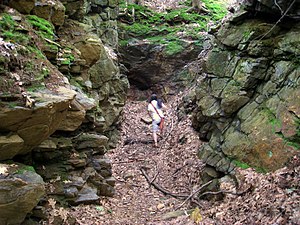Tantiusques
|
Tantiusques
|
||
| location | Massachusetts , United States | |
| surface | 23.1 ha | |
| Geographical location | 42 ° 4 ′ N , 72 ° 8 ′ W | |
|
|
||
| Setup date | 1962 | |
| administration | The Trustees of Reservations | |
Tantiusques is a 57 acres (23.1 hectare ) nature reserve near the city of Sturbridge in the state of Massachusetts in the United States . It is managed by The Trustees of Reservations organization.
history
The area was already used by the Nipmuck Indians before the arrival of European settlers for the mining of graphite , which occurs there in large quantities and after which the place was named; "Tantiusques" means something like "to a black deposit between the hills" in the language of the Indians. The Nipmuck used the graphite mainly for ceremonial paintings.
In 1644, John Winthrop, Jr. , son of the first governor of the Massachusetts Bay Colony , bought the mine and surrounding land from the Indians and established the first commercial mine in New England there . He assumed that lead and iron could be found there in addition to graphite . The mine remained in the family's possession until 1784, although the extraction of the valuable components was very laborious and the company made little profit.
In 1828 the Boston merchant Frederick Tudor bought the property and continued to mine graphite there. His employees also included Joseph Dixon and his son, who later jointly founded the JD Crucible Company in New Jersey , widely known for its pencils . The Dixon Ticonderoga Company , which is still active today, emerged from the company and produces general office supplies, but also continues to produce pencils. Graphite was also an important raw material in the manufacture of crucibles in which other materials are heated to high temperatures. In 1910, however, the mine was largely exhausted and closed.
George H. Haynes, professor at the Worcester Polytechnic Institute , took a keen interest in the history of the mine and in 1902 published the article The Tale of Tantiusques - An Early Mining Venture in Massachusetts . The Sturbridge Historical Commission then dealt with the plant and was finally able to achieve that the mine was entered on October 6, 1983 under the number 83004141 in the National Register of Historic Places . As early as 1962, Roger Chaffee, who had worked under Haynes, gave the property to the trustees.
Protected area
A 1.5 mi (2.4 km ) circular trail is available to visitors to today's protected area . In 2002 the Trustees bought the neighboring Robert Crowd Site , where the ruins of the house where Robert Crowd lived. He possessed both African American and Native American ancestors and worked in the mine in the 1850s.
The mine can still be clearly identified as it was essentially an open pit mine that followed the graphite seam and was several hundred meters long, 20 ft (6.1 m ) to 50 ft (15.2 m) deep and 6 ft (1.8 m) wide. However, work was also carried out underground; the youngest tunnel was built in 1902.
See also
Individual evidence
- ^ Property History. The Trustees of Reservations , accessed July 12, 2014 .
- ↑ About Tantiusques. The Trustees of Reservations , accessed July 12, 2014 .
Web links
- Tantiusques. ( PDF ) The Trustees of Reservations, 2013, accessed on July 12, 2014 (English, map of the area).
- Tantiusques on TripAdvisor


